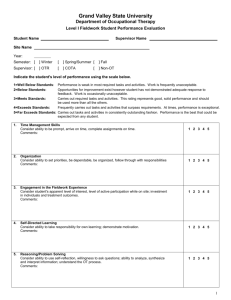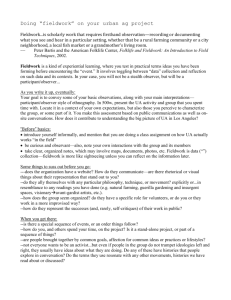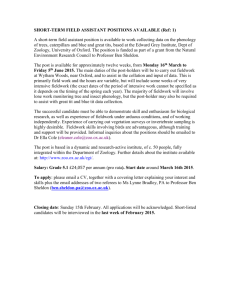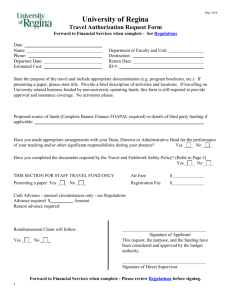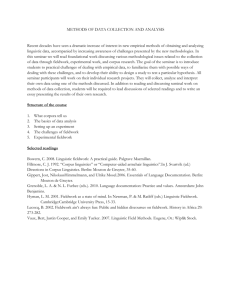VCE Geography 2016-2020 Frequently asked questions
advertisement
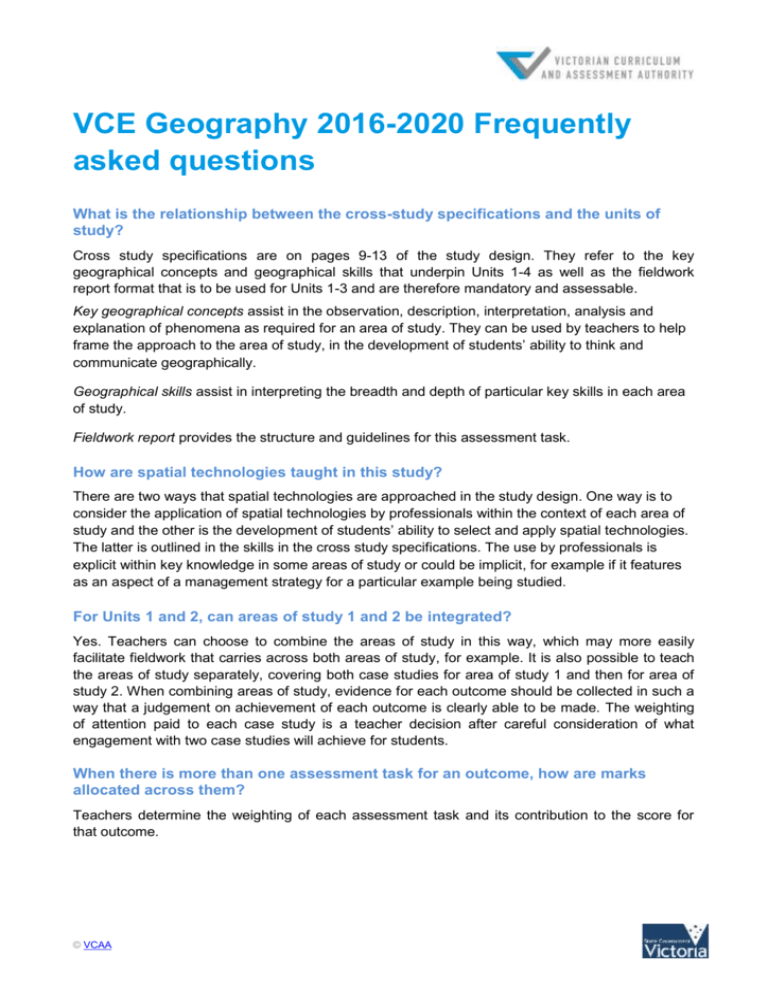
VCE Geography 2016-2020 Frequently asked questions What is the relationship between the cross-study specifications and the units of study? Cross study specifications are on pages 9-13 of the study design. They refer to the key geographical concepts and geographical skills that underpin Units 1-4 as well as the fieldwork report format that is to be used for Units 1-3 and are therefore mandatory and assessable. Key geographical concepts assist in the observation, description, interpretation, analysis and explanation of phenomena as required for an area of study. They can be used by teachers to help frame the approach to the area of study, in the development of students’ ability to think and communicate geographically. Geographical skills assist in interpreting the breadth and depth of particular key skills in each area of study. Fieldwork report provides the structure and guidelines for this assessment task. How are spatial technologies taught in this study? There are two ways that spatial technologies are approached in the study design. One way is to consider the application of spatial technologies by professionals within the context of each area of study and the other is the development of students’ ability to select and apply spatial technologies. The latter is outlined in the skills in the cross study specifications. The use by professionals is explicit within key knowledge in some areas of study or could be implicit, for example if it features as an aspect of a management strategy for a particular example being studied. For Units 1 and 2, can areas of study 1 and 2 be integrated? Yes. Teachers can choose to combine the areas of study in this way, which may more easily facilitate fieldwork that carries across both areas of study, for example. It is also possible to teach the areas of study separately, covering both case studies for area of study 1 and then for area of study 2. When combining areas of study, evidence for each outcome should be collected in such a way that a judgement on achievement of each outcome is clearly able to be made. The weighting of attention paid to each case study is a teacher decision after careful consideration of what engagement with two case studies will achieve for students. When there is more than one assessment task for an outcome, how are marks allocated across them? Teachers determine the weighting of each assessment task and its contribution to the score for that outcome. © VCAA VCE Geography 2016-2020 Frequently asked questions Do students need to study only two countries for Unit 4? In this unit students investigate the geography of human populations. They explore the patterns of population change, movement and distribution, and how governments, organisations and individuals have responded to those changes in different parts of the world. Area of study 1 requires study of a range of examples within and between countries with different economic and political conditions and social structures, while area of study 2 studies two countries in detail – one with a growing population and one with an ageing population. One aspect of area of study 2 is the interconnection between population dynamics and resulting issues and challenges. Therefore teachers may wish to introduce the countries that will be covered in area of study 2 as examples for area of study 1, although this is not a requirement. While the exact number of examples for area of study 1 is not stipulated, it is expected that students should be able to illustrate the dynamics of population from examples within and between different countries as outlined in the study design. To do this well, it may be necessary to go beyond the two countries that will be studied for area of study 2. What kind of fieldwork site should be selected for Unit 3, Area of study 1? Unit 3, Area of study 1, asks students to investigate land use change at a local scale using appropriate fieldwork techniques and secondary sources. They investigate the scale of change, the reasons for the change and the impacts of the change. Students undertake fieldwork and produce a fieldwork report using the structure provided in the cross-study specifications – fieldwork report. For the purposes of this curriculum, a good fieldwork site should: - Involve change at a local scale. Local scale is defined as a smaller area than regional, but could include a local portion of a land use change happening on a regional scale, for example a small area of a widespread conversion of grazing to plantation forests. - Involve a change of purpose in the landuse. That is, an enhancement or modification of an existing purpose should be avoided. It is possible that there may be multiple purposes on the site, for example commercial and residential. - Include relevant, good quality spatial and other data and information from before and after the change. There should also be data and information on the impacts of the change. This is how the term ‘recently occurred’ and ‘near future’ should be interpreted in the study design requirement that ‘change may have recently occurred, is underway or planned for the near future.’ For example, can ‘before and after’ maps be produced? - Support the development of key knowledge,skills and cross study specifications to the highest level The most important factor to consider in selecting a site are the requirements of the area of study and whether the key knowledge and skills and cross-study specifications be addressed to the highest standard, such that students not only have the opportuntity to receive a satisfactory result but an opportunity to achieve at the highest level. Finally, the aims of the curriculum should be considered, in particular developing a sense of wonder and curiosity. Illustrative examples: The following are examples of landuse change that are clearly appropriate: © VCAA Page 2 VCE Geography 2016-2020 Frequently asked questions Conversion of irrigated pasture in the Goulburn River catchment to dryland pasture (in this case the inputs to the landuse will change, infrastructure is likely to change, and there will be an impact on land surface processes, in this case hydrology through ending irrigation). Construction of a large farm dam that covers agricultural land with water. Conversion of market gardens to houses on the outskirts of Melbourne Construction of a new surf-life-saving club on coastal dunes Construction of windfarms on agricultural land Conversion of a former landfill site into a park, or into housing. The following provides clarification on issues that may arise in selecting a fieldwork site: Gentrification per se is not land use change. The mere movement of wealthier people into urban areas to displace the less wealthy does not necessarily constitute land use change. For example the renovation of a house is enhancement or modification to an existing purpose and is not a land use change. It is the case however that land use change can occur as a result of, or concurrent with gentrification, for example in the conversion of warehouses to residential use, or in the building of particular infrastructure such as community gardens, or in the replacement of residential housing land with mixed commercial/residential apartments and shops. Change of land classification per se is not sufficient to qualify as landuse change. For example, rural land could change its landuse planning zone from agricultural to urban, but this is a change of zone not necessarily of actual landuse. Students would need to be able to access data and information on specific land use changes planned in the near future as a result of this rezoning, and assessment of its likely impacts. Adding a gym, café, crèche, extended car parking and landscaping to council land occupied by a swimming pool, entry, changing rooms, paths and lawns counts as land use change, for while there is an overarching purpose of recreation, the land is changing to different broader recreation purposes. A simple refurbishment of the swimming pool would not be a land use change as the existing purpose is retained. A beach redevelopment to install new visitor and community facilities incorporating a cafe, kiosk, public amenities, refurbished accommodation for the Surf Life Saving Club and a community meeting space as well as improved stormwater drainage, beach access paths, a large car park, landscaping and improved signage, counts as a land use change. The community meeting space, café, extention of the car park onto unused land, are all land use changes. Merely improving signage, grading beach access paths or painting amenities would not constitute land use change. © VCAA Page 3

